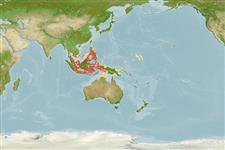Gastropoda |
Lepetellida |
Haliotidae
Environment: milieu / climate zone / depth range / distribution range
Ecology
Benthic. Tropical
Western Central Pacific: from Philippines to southern Indonesia.
Length at first maturity / Size / Weight / Age
Maturity: Lm ? range ? - ? cm Max length : 5.0 cm ShH male/unsexed; (Ref. 349); common length : 4.0 cm SHL male/unsexed; (Ref. 349)
The shell is ovate, with a low, non-protuding spire. Outer surafce smooth, with holes slighly raised from the shell surface, the last 5 or 6 holes open. Regularly convex outer lip of the shell. Colouration: outside shell greenish brown, with cream or whitish streaks and blotches; inside shell shiny, iridescent (Ref. 128042).
Found in coral reef (Ref. 128042) and shallow subtidal areas (Ref. 349, 128042), particularly rocky intertidal shores (Ref. 128042).
Life cycle and mating behavior
Maturity | Reproduction | Spawning | Eggs | Fecundity | Larvae
Members of the order Patellogastropoda are mostly gonochoric and broadcast spawners. Life cycle: Embryos develop into planktonic trocophore larvae and later into juvenile veligers before becoming fully grown adults.
Poutiers, J.M. 1998. (Ref. 349)
IUCN Red List Status (Ref. 130435)
CITES status (Ref. 108899)
Not Evaluated
Not Evaluated
Threat to humans
Harmless
Human uses
Fisheries: commercial
| FishSource |
Tools
Internet sources
Estimates based on models
Vulnerability
Low vulnerability (10 of 100).
